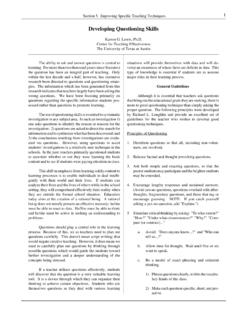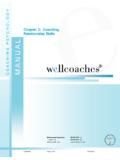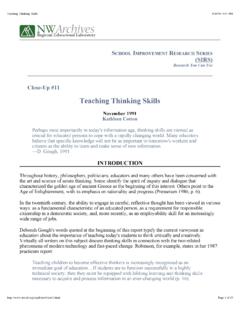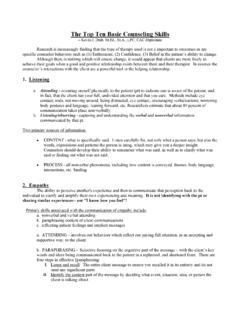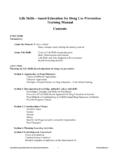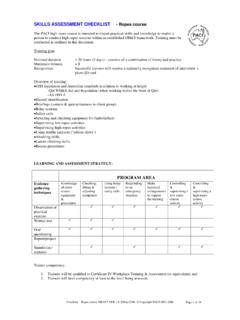Transcription of QUESTIONING - Wiltshire
1 QQUUEESSTTIIOONNIINNGG AAsssseessssiinngg aanndd DDeevveellooppiinngg CChhiillddrreenn ss UUnnddeerrssttaannddiinngg aanndd TThhiinnkkiinngg iinn LLiitteerraaccyy tthhrroouugghh EEffffeeccttiivvee QQuueessttiioonniinngg Wiltshire LA Literacy Team Autumn 2008 Page 2 QUESTIONING IInnttrroodduuccttiioonn This document has been produced to support the development of effective QUESTIONING and dialogue between teacher and pupils. The ideas contained within this document will give practical support in developing the skill of QUESTIONING .
2 It will help teachers by: Identifying a range of different questions that may be asked and used to assess children s understanding and thinking Providing an analysis of the range of questions that teachers use Questions are an essential feature of formative assessment as they enable child and teacher to identify what they know and can guide them in their next steps. Wiltshire LA Literacy Team Autumn 2008 Page 3 QUESTIONING FFoouurr ttyyppeess ooff qquueessttiioonnss CLOSED A closed question implies that the teacher has a predetermined correct response in mind OPEN An open question permits a range of responses LITERAL Literal questions are concerned with the recall of facts or simple comprehension where the answer is clearly stated in the text HIGHER ORDER Higher order questions make progressive cognitive demand on children.
3 They encourage children to think beyond the literal. The effective use of higher order questions enables teachers to assess children s understanding and thinking It is important that there should be an appropriate balance of literal and higher order questions for children in all age groups. Wiltshire LA Literacy Team Autumn 2008 Page 4 QUESTIONING AAsssseessssmmeenntt FFooccuuss ffoorr RReeaaddiinngg AF1 Use a range of strategies including accurate decoding of text, to read for meaning AF2 Understand, describe, select or retrieve information, events or ideas from texts and use quotation and reference to text AF3 Deduce, infer or interpret information, events or ideas from texts AF4 Identify and comment on the structure and organisation of texts.
4 Including grammatical and presentational features at text level AF5 Explain and comment on writers uses of language, including grammatical and literary features at word and sentence level AF6 Identify and comment on writers purposes and viewpoints and the overall effect of the text on the reader AF7 Relate texts to their social, cultural and historical contexts and literary traditions Points to remember when using the Reading AFs AFs are not hierarchical, age or ability related, and they define broad areas in which evidence can be examined in order to determine how well pupils are progressing Readers use a range of strategies to decode texts (AF1) which become more automatic with experience, as listening to pupils read throughout Key Stage 2 demonstrates Reading involves making meaning from content, structure and language (AFs 2-5) To develop as readers who can make sense of a wide range of texts, pupils need to be secure on AF3.
5 Securing AF3 is a vital underpinning for progress through level 4 and above The AFs which highlight evaluation and analysis (AFs 4-7) build on the skills in AFs 1-3 In exploring a text, readers respond to specific aspects (AFs 4-5) and to the text as a whole (AF6) Wiltshire LA Literacy Team Autumn 2008 Page 5 QUESTIONING TTyyppeess ooff qquueessttiioonnss Recall recalling or revising material that has already been covered Comprehension understanding the main points of a story Application transferring knowledge learned in one context to another Analytical analysing mood, setting, characters, expressing opinions and preferences, make inference and deduction.
6 Refer to text Synthesis developing a critical stance based on information from a range of sources Evaluation making judgements, explaining reasons for judgements, comparing and contrasting, developing reasoning using evidence Wiltshire LA Literacy Team Autumn 2008 Page 6 QUESTIONING EExxaammpplleess ooff LLiitteerraall QQuueessttiioonnss LLiitteerraall RReettrriieevvaall QQuueessttiioonnss ((AAFF22)) Reading AF2 To develop performance in AF2 children need to: Understand, describe, select or retrieve info, events or ideas from texts and use quotation and reference to the text.
7 This can be achieved by: Encouraging children to describe, retell and locate Modelling the above, making references to, and quoting from, the text Asking recall and simple comprehension questions during Shared and Guided Reading Recall Questions These questions will help children recall or revise material they have previously read. Where does the story take place? When did the story take place? What did s/he/it look like? Who was s/he/it? Where did s/he/it live?
8 Who are the key characters in the book? Where in the book would you find ..? Comprehension Questions Children show an understanding of the main points of a story. They describe what they know They give examples, summarise or outline key basic points in their own words They link stories with personal experience Describe .., the giant What do you think is happening here? What happened in the story? What might this mean? proudly Through whose eyes is the story told?
9 Which part of the story best describes the setting? Which words/phrases tell you that .. the setting is spooky Which part tells you .., they were annoyed that Goldilocks was in their house Why do ..? why do people need to look after their teeth? Wiltshire LA Literacy Team Autumn 2008 Page 7 QUESTIONING EExxaammpplleess ooff HHiigghheerr OOrrddeerr QQuueessttiioonnss HHiigghheerr OOrrddeerr QQuueessttiioonnss ((AAFF33,, AAFF44,, AAFF55,, AAFF66,, AAFF77)) Reading AF3 To develop performance in AF3 children need to: Deduce, infer or interpret information, events or ideas.
10 This can be achieved by: Encouraging children to compare, contrast and infer Modelling the above by making reference to, and quoting from, the text Asking analytical and synthesis questions Reading AF4 To develop performance in AF4 children need to: Identify and comment on structure and organisation of texts. This can be achieved by: Making very explicit links between reading and writing especially the ways in which texts are organised Modelling the language needed to comment upon authors use of structure, organisation, grammar and presentation Using genre checklists to highlight the layout features and language features of different texts Asking analytical questions and questions requiring synthesis.

